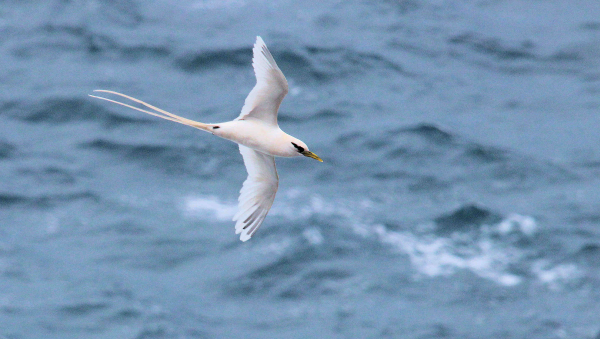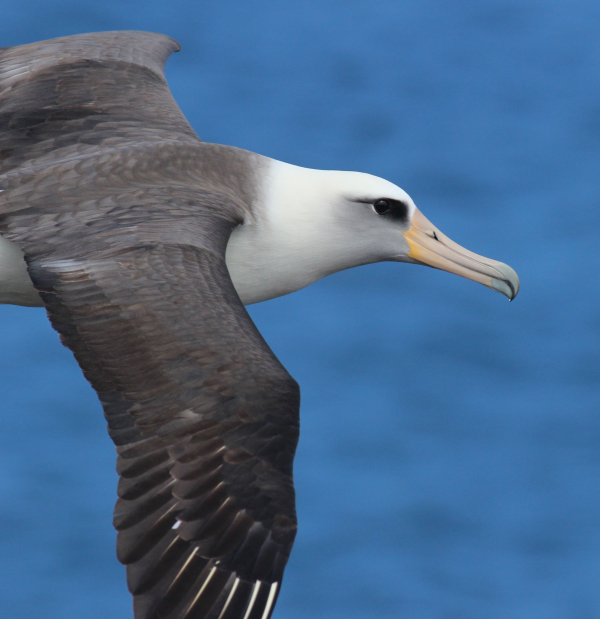
Few people get to see an albatross this close, and to photograph it in flight was an absolute thrill. The camera settings for this Laysan Albatross portrait were f10 and 1/800 at ISO 400.
|
This has been a long, hard, windy, ultra-cold winter up north, and as I pondered my next opportunity to photograph birds locally within a few hours’ drive, there were No sunny days in the week’s weather report, and every day was way too windy to expect to find many birds along the way or at my “destinations.” That’s when I began to reflect on a bigger trip, staying in the United States, but stretching it to the limits, ya know.
That’s when the daydreams of Kaua’i began, not so much novel daydreams, but more fond memories of the Hawaiian fun I had while photographing birds at Kilauea Point, and my thoughts returned there. Usually, seabird photography requires a ship – or at least passage on a seabirding day cruise, but on the paradise isle of Kaua’i, it’s possible to photograph remarkable species of seabirds from shore.
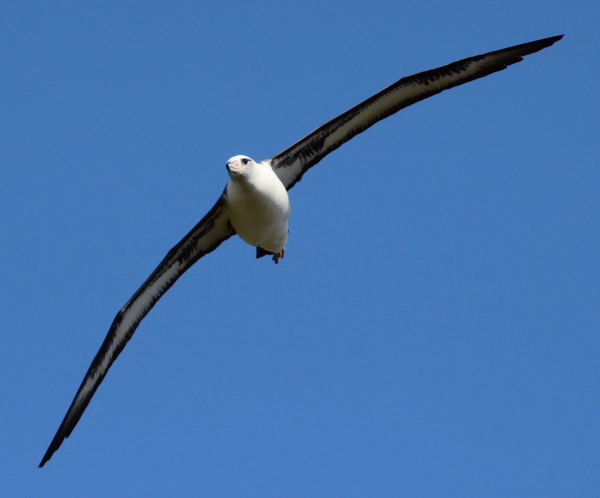
Getting a photo showing the full wingspan of this gliding Laysan Albatross also reveals the aerodynamics of this graceful seabird.
|
Actually, “shore” is a long cliff ending at the Point – Kilauea Point is the northern-most point on Kaua’i, and it’s also the most northern point in the Hawaiian archipelago. Kaua’i is a beautiful island that rivals and surpasses many South Pacific island destinations, and the birds are similarly impressive. But it was the seabirds more than any others that held my attention, and the chance to photograph them from the top of a high cliff that provided updrafts for the gliding birds was thrilling and it seemed quite unique.
The birds included such impressive seabirds as albatrosses, tropicbirds, boobys, and frigatebirds! The species included Laysan Albatrosses, Red-tailed Tropicbirds, White-tailed Tropicbirds, Brown Boobys, Red-footed Boobys, and Great Frigatebirds – all spectacular large birds that commanded a level of dedication to watching, following, and timing photos of these seabirds through my camera’s viewfinder. These seabirds all sped by without moving a wing, propelled by updrafted wind that was forced upward by the tall steep cliff faces – plus gravity as the birds turned their flights in a variety of directions. The opportunity to try to photograph them was a personal thrill, and a good workout for my camera and 400mm telephoto lens.
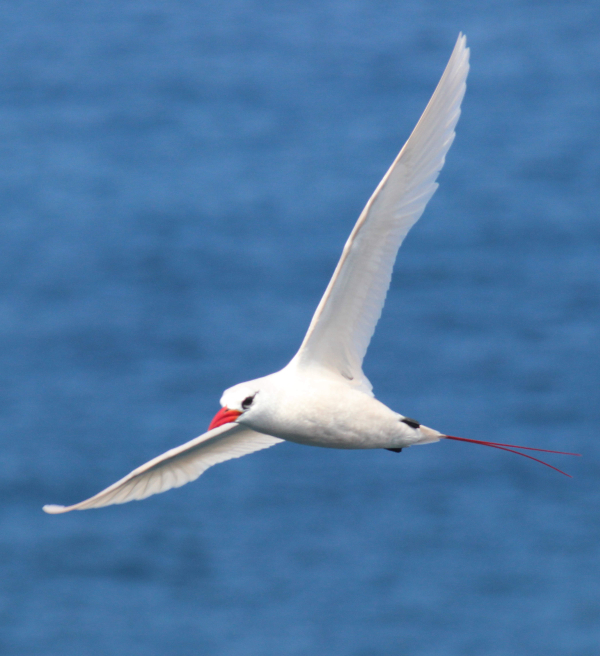
Tropicbirds appear angelic in their graceful gliding flights, with this dramatic image showing the red bill and tail of indicative of a Red-tailed Tropicbird. Shadows on the bird are subdued and actually add some dimension to white the plumage.
|
A zoom lens might have been a plus at times, but zooming in and out takes another level of action, and in this case I was probably better off just concentrating on the seabird flights with one less activity to address in the process. It’s worth noting that while I was there, during the first week of March, there were almost always Hump-backed Whales in sight, and sometimes they swam near enough to photograph their activities when they splashed their tails against the water, or breached over the ocean’s surface and plunged back into its depths – so there was plenty of photo action at Kilauea Point.
Actually, Kilauea Point is a national wildlife refuge and it’s a popular destination for many vacationers who enjoy the historic lighthouse and the dramatic views from the cliff that juts north into the Pacific Ocean. As a result, the location provides a welcome safety measure in the form of a railing that allows you to feel safe, stop worrying about falling off the cliff, and provides a handy place to lean your camera, or at least your hips if you are pivoting as you follow the flight of a gliding albatross.
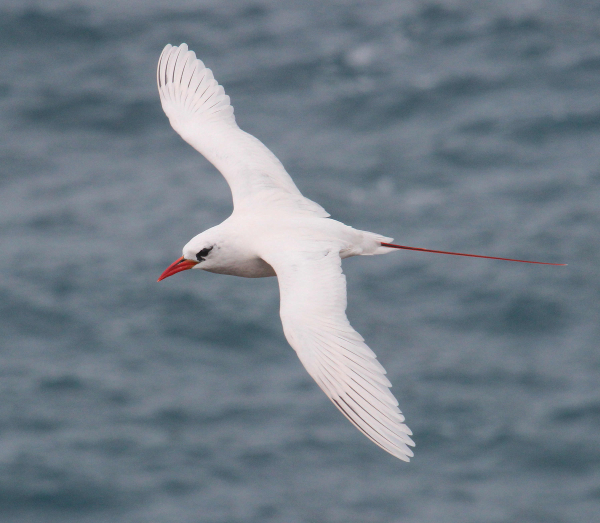
In this photo taken from overhead during a cloudy period, the light played beautifully on this Red-tailed Tropicbird, contrasting with the ocean below.
|
The direction of the sunlight was always a consideration, so I tried to time my photography for sunny periods and position myself as best I could between the sun and the birds I was photographing. At times, birds were actually flying below you, which provided some interesting angles on the birds, and from the standpoint of sunlight direction, you had full sunlight on their back. Conversely, when birds flew overhead, their underside was shaded, which was less than optimal lighting. Anytime, I had to be aware of how shadows were affecting the photos, and by taking a look at representative photos on the small screen on the back of my camera, I could try to adjust my position or be more aware of when shadows were forming on the seabirds.
At this location, the seabirds are almost always in motion, in flight; often in fast flight; usually gliding. The fast gliding flights of the seabirds gave my autofocus a good workout to be sure.
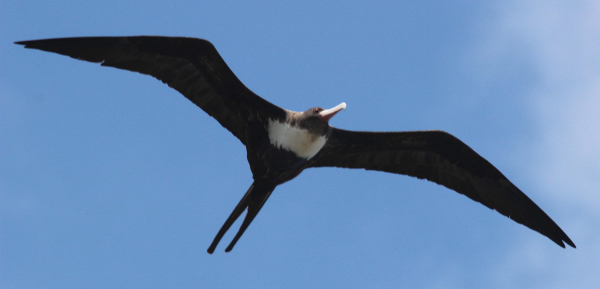
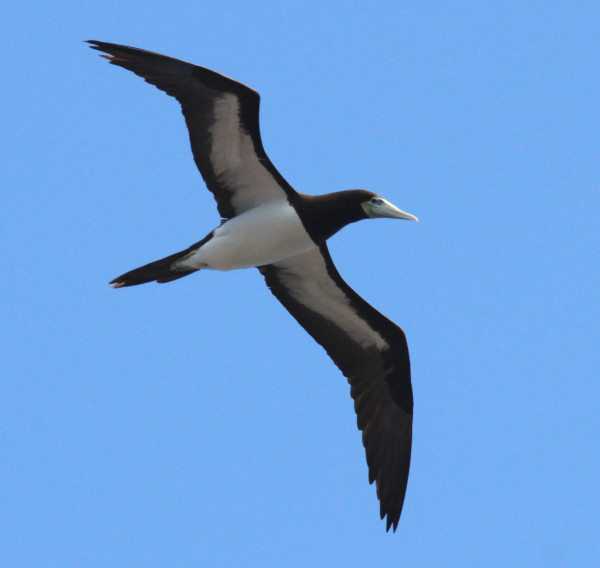
Although it is stopped in mid-flight in this photo, you can imagine the speed of this Brown Booby. Photographed from below, its ventral side is shadowed, which dulled the white plumage and reduced the contrast with the dark brown coloration.
|
And photographing the flights required a fast shutter speed to get the best photographs of the seabirds – usually 1/800 to 1/1600 of a second. At the same time, the albatrosses and frigatebirds have especially broad wingspans, so an adequate aperture of at least f8 was required. But actually, I found myself using an aperture setting of f9, f10, or f11, with plenty of shutter speed to stop the seabirds’ flight action.
Ready for action with these tech settings, the seabirds provided an array of angles to photograph them – coming, going, parallel, above, below, close, distant, and all points in between. The albatrosses were dramatic, the tropicbirds graceful, the frigatebirds ominous, and the boobys always impressive among the mix. The action at Kilauea Point is both exciting and impressive, as well as a unique situation that makes this location one I will often recall and daydream about. I may even review the photos I took there again, like I did this week, with the hope of returning for another round of seabird photography in the north of Kaua’i. For now, I’m glad to share my photos and recollections of this memorable location filled with remarkable seabirds.
Article and photographs by Paul Konrad
Share your bird photos and birding experiences at editorstbw2@gmail.com
